Jupiter
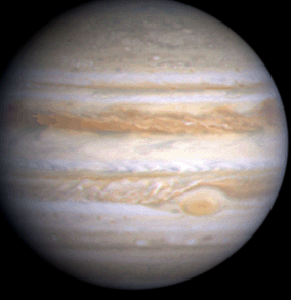



is the largest planet in the solar system (142,984 kilometres in diameter) and can be easily seen from Earth without a telescope. It orbits the Sun in 11.8623 Earth years, at a speed of 13.06 km/s.
Named after Roman father of the gods who was the god of fun, it also represented tin, green, triangle, 8, and Thursday (French=Jeudi). English name after Thor god of thunder, Greek name Zeus was Greek god of thunder. Chinese called it the Year Star - as their calendar cycle (which originated in India) was based on a Jupiter year of approximately 12 years , also represented the element wood, the direction of east.
Jupiter is really a small star, almost, but not quite, large enough for gravitational pressure to heat the core sufficiently for nuclear fusion to occur. Only slightly denser than water (1.314 g/cm3 overall), it seems to be nearly or all gas, mostly hydrogen fiercely gusting in whirling storms down to the centre where the fierce heat keeps the higher density core fluid. It rotates in less than 10 hours. (9.841 hours).
With only a small telescope it is possible to see the bands of clouds across Jupiter and the largest almost permanent storm system, The Great Red Spot, as well as the four largest moons.
![]() Jupiter's four largest moons were first observed by Galileo using the telescope he had made with the assistance of his toolmaker Marc'antonio Mazzoleni, and a glass maker to make the lenses.
Jupiter's four largest moons were first observed by Galileo using the telescope he had made with the assistance of his toolmaker Marc'antonio Mazzoleni, and a glass maker to make the lenses.
In January 1610, Galileo realised there were four moons orbiting Jupiter. This was a new and significant discovery and he rushed to publish this in a book called "Siderius Nuncius" (The Starry Messenger) in March. With regard to publicity and funding, Galileo dedicated his work to the ruler of Tuscany Cosimo Medici, and suggested he named the newly discovered moons of Jupiter after him and his family. He got the reply to name them the Medicean satellites. Later astronomers to whom the once powerful Medici dynasty meant nothing preferred to call them the Galilean moons.
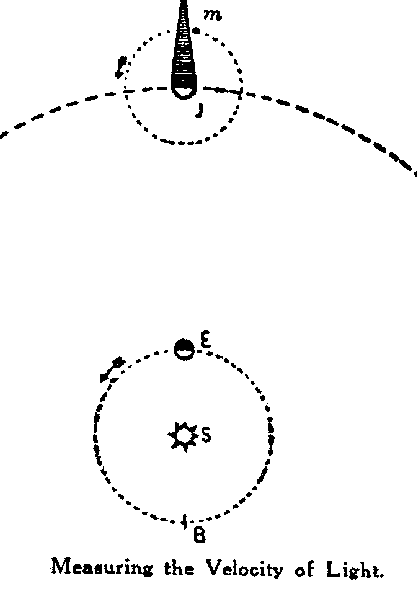 When Galileo observed the four largest moons of Jupiter through his telescope, in 1610, and saw how quickly they orbited round Jupiter he thought the timing of their eclipses could be used to determine longitude. Tables were made predicting the eclipses.
When Galileo observed the four largest moons of Jupiter through his telescope, in 1610, and saw how quickly they orbited round Jupiter he thought the timing of their eclipses could be used to determine longitude. Tables were made predicting the eclipses.
The moons of Jupiter can only be seen through a telescope, and trying to hold and focus a telescope on Jupiter, on a boat bobbing about on the sea was of course, impossible. This did not prevent attempts to use this method at sea from the 17th to the 19th century.
The eclipses of Jupiter's moons were useful in finding the longitude of places on land. The Italian astronomer, Giovanni Domenico Cassini (1625-1712) complied and published tables for Jupiter's satellites. In 1668 he was invited by Louis XIV of France to head the new observatory in Paris. Here he was working with Jean Picard (l620-1682).
To aid their observations they planned in 1671 to get observations of Io's eclipse from the site of Tycho Brahe's observatory on the island of Hveen off the coat of Denmark, which could be compared with simultaneous observations made of the same event from Paris.
Picard was assisted in Denmark by the professor of mathematics at Copenhagen University, Erasmus Bartholin (1625-1698) and his student and son-in-law, Olaf (Ole) Roemer (1644-1710). Roemer was invited by Picard to work in Paris, where he also had to teach the Dauphin maths.
A brilliant scientist and inventor, one of his most famous - and at the time controversial discoveries - was the speed of light, from his observations of the orbits of Jupiter's moons. He noticed the time difference in the observations of the eclipses, at different times of the year when the Earth and Jupiter were at different positions in their obits and from this was able to deduce the speed of light.
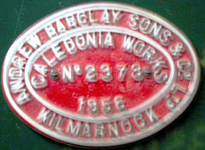 by Andrew Barclay, FRAS, Engineer, Argyll House, Kilmarnock. (He made steam locomotives.)
by Andrew Barclay, FRAS, Engineer, Argyll House, Kilmarnock. (He made steam locomotives.)Jupiter was and still is a good target for the amateur. In the 19th century, the British Astronomical Association was founded for amateur astronomers, and the Royal Astronomical Society admitted both amateur and professional. At the time the dividing line was blurred - a wealthy amateur could have a professional observatory. Results, and queries, letters and feedback were catered for by society journals and more general magazines like the English Mechanic.
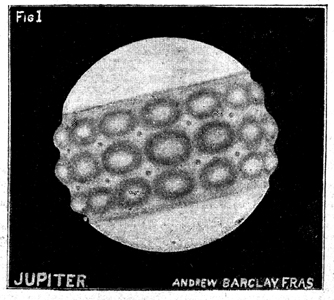 It was in the English Mechanic of 20th October, 1893, that Andrew Barclay sent in his results from his 9in. and 14 1/2in. Gregorian telescopes, claiming proudly that "I mean to show what the greatest or best telescopes should look for..." with descriptions of his expensive efforts over the mirrors. "Fig.1 is a drawing of Jupiter which shows three rings of oval, egg-shaped mounains, with four annular valleys which are seen on the edge, as shown on the drawing."
It was in the English Mechanic of 20th October, 1893, that Andrew Barclay sent in his results from his 9in. and 14 1/2in. Gregorian telescopes, claiming proudly that "I mean to show what the greatest or best telescopes should look for..." with descriptions of his expensive efforts over the mirrors. "Fig.1 is a drawing of Jupiter which shows three rings of oval, egg-shaped mounains, with four annular valleys which are seen on the edge, as shown on the drawing."
Barclay after further description, said that "I brought this before the Royal Astronomical Society on the 10th December 1880, and they refused to read my paper, as they said no such thing existed on Jupiter."
He also received a note from the Assistant Secretary "Dear Sir, - I should prefer to see for myself what your drawing represents as existing on Jupiter before I believe it." -
Barclay tried to get his paper read in November 1892 at the British Astronomical Association, only to be told by the assistant secretary that "the telescopes must be distorting the image, as no such things existed as shown on my drawings.
He put it before the council, who refused to read the paper.
"I also showed Lord Kelvin a model of Jupiter which I had made. He advised me to go home and think no more about it, as no such things existed on Jupiter. I also showed the astronomer Royal of Edinburgh the same model. He said there must be something wrong with my telescope, as no such thing existed on Jupiter."
Barclay's observations attracted many letters in feedback. "- some ask me how I account for the drawing of Jupiter; that I must have deceived them, as no instrument of my make defines well enough to show the gigantic nest of eggs that Jupiter is incubating." ".. the same correspondent thinks it very strange that, if the "revelation" of the nest of eggs (they may be mares' eggs) is due to superior defining power, why Mr. Barclay sees nothing of the north or south belts seen by other telescopes."
"The extraordinary drawing of Jupiter which appears in Mr.Barclay's letter on p.198 will no doubt cause some comment among your astronomical readers, most of whom (if not all) will agree with the adverse opinions so naively detailed in his letter, and will consider that the refusal to accept his papers was judicious, time and space being too valuable to waste."
"I have been much interested by Mr. Barclay's letter and drawing of Jupiter. The latter is quite a revelation. At school ... (assisted by the birch rod), "I learnt something of the doings of Jupiter and the other classical dieties. One of the duties of Jupiter's position on Olympus was, I suppose, to preside at the feasts of the gods, but I never thought that after the lapse of ages he still represented such unmistakable evidence of the effects of drink and dissipation."
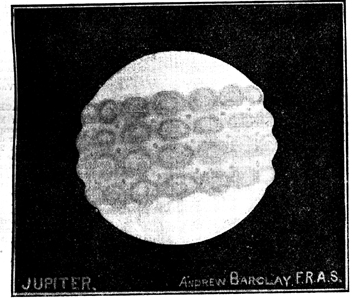 Not everyone was rude about Barclay's observations, some letters were much kinder, he had his supporters who pointed out that Copernicus and Galileo had their critics in their day. They admired his persistence too, in also showing his results for Mars, Venus and Saturn which also invited ridicule.
Not everyone was rude about Barclay's observations, some letters were much kinder, he had his supporters who pointed out that Copernicus and Galileo had their critics in their day. They admired his persistence too, in also showing his results for Mars, Venus and Saturn which also invited ridicule.
Barclay persisted. In the November 23rd issue of the English Mechanic another letter was accompanied by his drawing of his improved observations. (See picture left) This attracted more comments with drawings - none of which were anything like Barclay's.
Until it was possible to send out a probe, even photographs could do little better than the drawings.
By the 1950s an amateur astronomer was receiving radio signals from Jupiter in his converted Martello Tower. This is something the amateur can now do at home.
Many more sites, books etc. This is a popular project in radio astronomy and a field in which the amateur at home can still be of use.
Then came
then
More information came in the 1970s with the launch of Pioneer 10 and 11, in 1972 and 1973, and Voyager 1 and Voyager 2 in 1977. The Pioneer probes discovered that much of the heat that powers Jupiter's weather system comes from inside the planet. Jupiter radiates nearly twice as much heat as it receives from the Sun. They also measured Jupiter's powerful magnetic field and radiation belts. Jupiter is a strong radio source, second in power in the Solar System to the Sun.
The Voyager probes transmitted back to Earth much clearer images of the bands of whirling clouds on Jupiter's surface. They discovered that Jupiter had a thin ring of particles surrounding it to a distance of about 57,000 kilometres above the cloud tops. Also for the first time Jupiter's satellites could be seen in detail, and more satellites were discovered.
Voyager completely changed our view of the solar system.
The crash in July 1994, of fragments of comet Shoemaker-Levy-9 into Jupiter, left enormous holes the size of the Earth, as each fragment impacted raising great clouds of material. It was hoped that more information about the interior of Jupiter would be gleaned from the observations made of an event that was far more catastrophic than anticipated. Jupiter still bore the scars months later. Watching Earth sized holes punched into Jupiter raised a new awareness of the chances of something hitting Earth and what the consequences would be.
Further information on Jupiter and its moons came from Galileo, launched in 1989, which arrived at Jupiter in 1995. The data Galileo sent has given information on Jupiter's atmosphere which was very different to what was expected. The atmospheric density and temperatures were higher than anticipated. The winds fiercer, up to about 330 miles per hour. It found no clouds of water, not much lightning and and the atmosphere is predominantly hydrogen. Water has been found in some parts of Jupiter, so some form of life might even be possible. Galileo plunged into Jupiter's crushing atmosphere on Sept. 21, 2003. The spacecraft was deliberately destroyed to protect one of its own discoveries - a possible ocean beneath the icy crust of the moon Europa.
Galileo was the first spacecraft to fly past an asteroid and the first to discover a moon of an asteroid. It provided the only direct observations of a comet colliding with a planet. Galileo was the first to measure Jupiter's atmosphere with a descent probe and the first to conduct long-term observations of the Jovian system from orbit. It found evidence of subsurface salt water on Europa, Ganymede and Callisto and revealed the intensity of volcanic activity on Io.
63 found so far. - The IAU in 2004 commented that it was now possible to discover satelites less than 1 km in size - and sometime they would have to review their policy of naming the smallest. They are running out of using the names of the god Jupiter's (Zeus) lovers - many as they were and will now also use names of his daughters etc.
The four largest satellites are all planet sized and were first discovered by Galileo - they are:
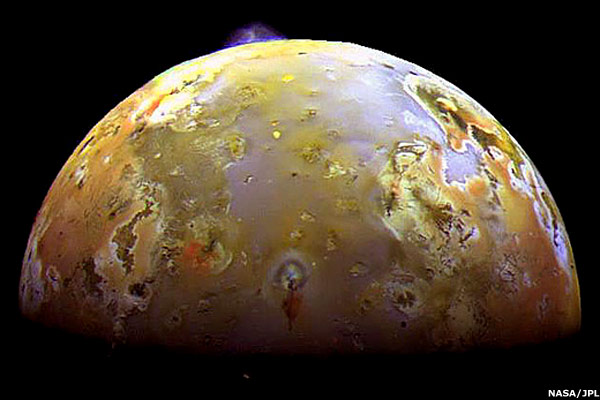
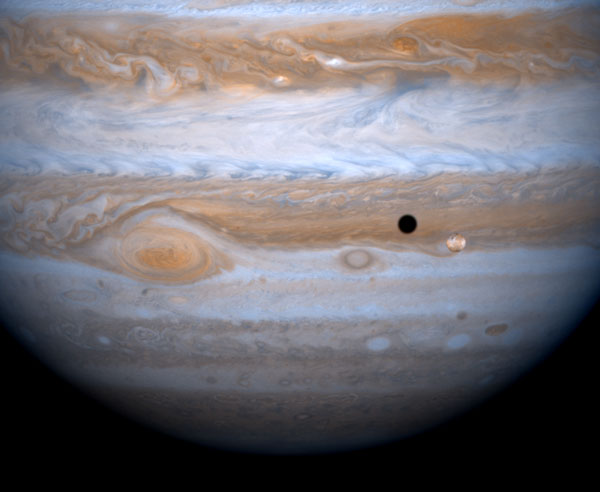
Io is a fairly dense body of iron and rock. Its surface is covered by red and yellow sulphur from the huge active volcanoes - the most actively volcanic of the planets.
An eruption of the largest volcano, Pele (named after the Hawaiian goddess of volcanos) was discovered by engineer Linda Morabito. Io's second largest volcano is called Loki. Material was seen ejected up to 200 kilometres.
The eruptions from Io leave a ring round Jupiter in its orbit. The reason for such activity is the tides. Io is in resonance with Europa, for every one orbit made by Europe, Io makes two. The tugging between the two satellites as they pass each other always in the same place in their orbits causes their orbits to become eccentric. The tidal force from Jupiter tries to pull the orbits back into circles. This pulling releases energy into the satellites heating them up. In Io, the heating is so great that it causes continuous volcanic erruptions.
The names of surface features on Io are taken from gods and heroes in the world's myths associated with fire, thunder, volcanoes, the sun and the story in Greek mythology in which Jupiter disguised himself as a cloud to get his leg over Io.

This is a body of rock and ice. It is covered in cracked ice. There are few impact craters which indicates there has been recent geological activity. The tidal heating is enough to melt the ice, but not enough to power volcanos. The Galileo fly-past in June 1996 showed features on Europa that resembled the ice in the Arctic ocean on Earth. Europa has an icy crust that has been severely fractured. Europa's density indicates that it has a shell of water ice as thick as 100 km.
Europa has now been mapped. The pictures sent back by Galileo, looked as if Europa's surface was covered by roads or canals. These dark lines are the cracks in Europa's icy surface. Some of these fractures are as much as 30 km. across. They are filled with icy slush mixed with rocky debris. Some of the ice plates had been separated and moved round into new positions. The movement of the icy plates indicates that the ice is not solid down to the rocky interior of the planet but there may be a layer or slush or liquid water below the surface. This means that there is the possibility of life on Europa.
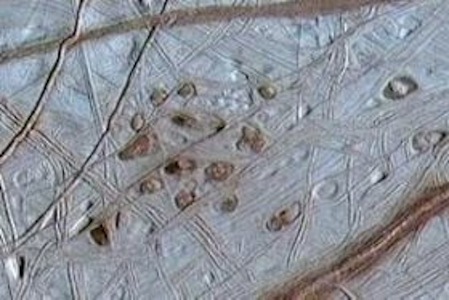 Evidence now found of a great lake on Europa.
Evidence now found of a great lake on Europa.
In December 2013, jets of water vapour were thought to have been seen on Europa, but these have not been observed since. Further observations will be made using Hubble, from the end of 2014 to early 2015 to confirm if these jets exist.
The names of features on Europa are taken from European gods and heroes, ancient Egypt and the story in Greek mythology in which Jupiter disguised himself as a bull to get his leg over Europa.
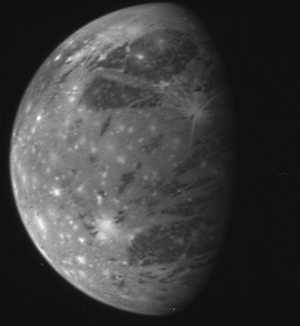
The largest of Jupiter's moons, bigger than the planet Mercury, but much lower density. Ganymede is mostly ice. It has an icy surface with ice mountains caused by orogony as on Earth. It is so cold at this distance from the Sun, the ice can freeze further into harder states in which it behaves like rock. Some areas on Ganymede have many craters, while other parts have very few craters indicating that the surface here is newer and that the planet could be still geologically active. The Galileo fly-by in June 1996 showed ancient cratered ice fields and younger volcanic plains, ridged ice mountains, deep furrows and smooth basins, the products of tectonic forces. About half of Ganymede's older cratered surface has been resurfaced by younger tectonic activity. Ganymede has its own magnetosphere - the region of charged particles that surrounds many planets, as it does the Earth. This shows that Ganymede probably creates its own magnetic field. As Ganymede is within Jupiter's magnetosphere this is a magnetosphere within a magnetosphere.
Names of features on Ganymede are taken from ancient Egypt and the fertile crescent. Ganymede was a young lad Jupiter fancied who was employed as cupbearer to the god.
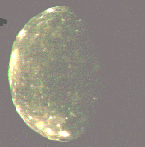
A heavily cratered surface shows it is a dead world and has been for a very long time.
Names of features taken from Northern myths. In Greek mythology Callisto was changed into the Great Bear constellation by Jupiter's long suffering wife Juno (in Greek Hera) to escape Jupiter's adulterous intentions.
Other satellites follow the tradition of being named after those women and boys Jupiter chased with lecherous intent, which gave a big choice...- but even that has not been enough - so some are now being named after his children etc.
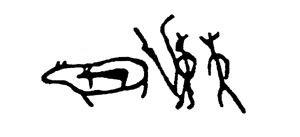 |